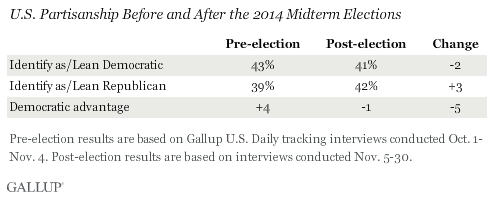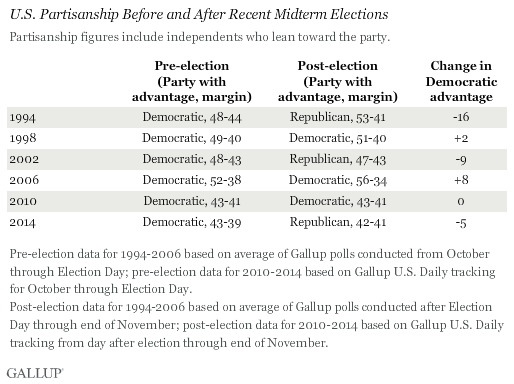Gallup was one of the first big time pollsters to attract a lot of attention for successfully predicting elections.
This is what is has to say about current feelings of American voters"
U.S. Partisanship Shifts to GOP After Midterms
Story Highlights
- U.S. partisanship shifts to net-Republican after midterms
- GOP also made gains after 1994 and 2002 midterms
- Democrats made gains following 2006 midterms
PRINCETON, N.J. -- Since the Republican Party's strong showing on Election Day last month, Americans' political allegiances have shifted toward the GOP. Prior to the elections, 43% of Americans identified as Democrats or leaned toward the Democratic Party, while 39% identified as or leaned Republican. Since then, Republicans have opened up a slight advantage, 42% to 41%, representing a net shift of five percentage points in the partisanship gap.

The pre-election results are based on Gallup Daily tracking interviews with 17,259 U.S. adults, conducted between Oct. 1 and Nov. 4. The post-election interviews are based on 12,671 interviews conducted Nov. 5-30.
There have been similar "bandwagon" effects for the winning party in the past, including after the 1994 and 2002 midterm elections, when Republicans benefited, and after the 2006 election, when Democrats made gains.

The most dramatic shift occurred after the 1994 midterms, in which Republicans picked up more than 50 seats in the House of Representatives to gain a majority in that chamber for the first time in 40 years. Before the 1994 elections, Democrats enjoyed a four-point advantage in party affiliation, but after the GOP wave, Republicans emerged with a 12-point margin, for a total shift of 16 points in the gap.
In 2002, Republicans capitalized on the popularity of George W. Bush to accomplish the rare feat of having the president's party gain seats in Congress in a midterm election. After that strong showing, partisanship moved from a five-point Democratic edge to a four-point Republican margin.
Four years later, with Bush's job approval rating stuck below 40%, Democrats gained control of both houses of Congress. An already strong Democratic partisanship advantage of 14 points swelled to 22 points after the election.
Not every "wave" election has produced a distinct shift in a party's advantage. The 1998 and 2010 midterms were also notable for their outcomes, but did not produce any apparent change in Americans' basic party loyalties. In 1998, Democrats gained seats in the House even with a Democratic president in office. In 2010, Republicans gained a net of 63 seats in the House to win back control of that chamber. That year, the shifts in party allegiances seemed to be in place before the election, with the smallest Democratic edge seen in any recent midterm year. Consequently, in 2010 it appeared that shifts in party allegiances drove the election results, whereas in other years the election results seemed to produce shifts in party affiliation after the election.
The bandwagon effect can largely be explained by the amount of positive publicity given to the victorious party after its success. However, it is unclear why there would be a bandwagon effect following most midterm elections but not all of them.
No Clear Historical Pattern on How Long Post-Midterm Party Gains Last
One key question is how long the effects persist when they do occur. A review of the three elections with obvious bandwagon effects reveals no consistent pattern.
- The 1994 Republican surge in partisanship was the largest and the longest lasting. Republicans maintained a healthy eight-point advantage in partisanship through December 1994, and an average four-point advantage from January through March 1995. By April, Democrats had regained a slight edge, and for the most part held it throughout the remainder of the year.
- The 2002 Republican gains were fairly short-lived, evident in November and December and largely gone by January 2003. However, when the Iraq War commenced in March, Republicans saw another surge in partisanship.
- The 2006 Democratic gains were the most brief, disappearing by December -- though that still left the party with a healthy 12-point edge in partisanship.
Implications
The 2014 midterms were an unqualified success for the Republican Party. The GOP took control of the Senate and expanded its majority in the House, giving Republicans control of both houses of Congress for the first time since 2006. And that success has caused Americans to view the Republican Party more favorably than the Democratic Party, as well as to say congressional Republicans should have more influencethan President Barack Obama over the direction the nation takes in the next year. Americans are also now more likely to align themselves politically with the Republican Party than the Democratic Party.
It is not clear how long these good feelings toward the GOP will last. That could be influenced by what Republicans do with their enhanced power. While they are unlikely to achieve many of their major policy objectives with a Democratic president in office, how they and the president navigate the key issues facing the nation over the next two years will go a long way toward determining where each party stands heading into the 2016 presidential election.
Survey Methods
Results for this Gallup poll are based on telephone interviews conducted Nov. 5-30, 2014, on the Gallup U.S. Daily survey, with a random sample of 12,671 adults, aged 18 and older, living in all 50 U.S. states and the District of Columbia. For results based on the total sample of national adults, the margin of sampling error is ±1 percentage point at the 95% confidence level.
Each sample of national adults includes a minimum quota of 50% cellphone respondents and 50% landline respondents, with additional minimum quotas by time zone within region. Landline and cellular telephone numbers are selected using random-digit-dial methods.
Learn more about how the Gallup U.S. Daily works.
No comments:
Post a Comment
Please leave a comment-- or suggestions, particularly of topics and places you'd like to see covered